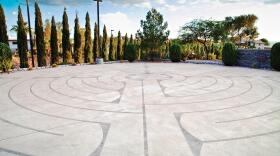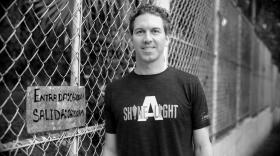Designer Mandy Telleria uses her skills to give others the helping hand she never got
Raised in Elko by a single mom, Mandy Telleria knows what it’s like to struggle. She saw her mom work nights and weekends as a server and blackjack dealer to raise two kids. Lots of things broke down in their house. The family once went without a fridge for six months. Their struggles were even tougher because her father was a wealthy developer who also lived in Elko but left his wife and never supported his family.
Art was her way out. When she was 9, an aunt bought her paper and nice pencils, and Telleria proved an adept illustrator. She went on to study interior design at UNLV and graduated in 2007.
Five years ago, while working as a designer in Las Vegas, she fell into what she calls an “extremely deep depression.” Most people work through a tough patch by focusing on their needs. Her solution was to “stop trying to solve my own problem and help someone else solve their problem. Let me use my skills and put them to use for good.” Design, she felt, could have great purpose, but too often was superficial. Some cool new building with a cool new shape designed to sell cool new things or cool new experiences. Surely design could be about more.
At the end of 2014 she sought out nonprofits looking for pro bono architectural services. She quickly lined up two clients and started the Good Deed Project (it received official nonprofit status in 2017). She teamed up with a teen pregnancy shelter, Living Grace, to renovate a bathroom with bad plumbing. The job took three months to plan and three more to complete. She found donors and cold-called subcontractors to help do the work.
The second project proved more daunting. She partnered with Safe House, the domestic-violence shelter where 60 women and their children live, on an array of projects: rehabbing the entire exterior and creating a new playground, gardening spaces, and a barbecue area; and renovating interior spaces, including a living room, dining room, bathrooms, and new floors. “We had to gut everything and redo everything, even the landscaping,” says Judy Belanger, a board member with Safe House.
Telleria was game. She reached out to women at the shelter for their input. She tapped a network of volunteers and vendors. Alex Baker, a childhood friend from Elko, was a project manager with Silver Lands, a landscape architectural contractor. His firm created a playground and a small planter garden. “Give Mandy credit she’s due for combining all the different trades,” Baker says.
Another key ally was Doris Mejia, who worked as an HR manager at Lowe’s in Henderson; among her jobs was to identify, once a year, nonprofits in need of renovation assistance. Telleria gave her a presentation of everything she had in mind for the Safe House renovation. “It blew me away,” Mejia says. “It was way above the scope of what we’d ever done.” It was beyond what a single Lowe’s store could do.
Undeterred, Telleria put together a PowerPoint that Mejia could take to other stores — ultimately eight other Lowe’s each agreed to supply materials and labor to renovate one of nine units (one unit consists of two bedrooms and a bathroom). The work proved so demanding that Lowe’s ended up paying its workers for their time. Telleria hadn’t anticipated how long it would take: almost three years. Through it she has come to rely on local suppliers to donate material and local architecture firms to donate storage space.
“Mandy was so organized,” Mejia says. “She knew what she wanted, she knew what would work and what wouldn’t. ... She had a lot of know-how.”
“We’re more than thrilled. It was an amazing project. Mandy was so patient, she had such a positive attitude about everything,” Belanger says. “Some of the women who were going to be moved from the old suites to the new ones, they would cry, (saying) ‘I cannot believe I can live in this beautiful environment.’”
After the Safe House job, Telleria shifted her focus to smaller, nimbler projects — working with individual families and single mothers who need help with basic maintenance, what she calls “pain points” for folks living in deteriorating homes who can’t afford critical repairs.
Last year she helped out a family of five — a single mother, Ana, her mother, and three teenage boys, one recently diagnosed with MS. They were living in a small, two-bedroom trailer home. There were no beds, just mattresses on the floor; her grandmother and one of her sons were sleeping in one bed. Worse, there were holes in the floor.
With her team of suppliers and volunteers, Telleria oversaw the renovations in two weeks. She put in a new kitchen, including new appliances and cabinets. She put in a partition with sliding doors. Ana had been sleeping in the kitchen on a sofa. Telleria moved her into the living room. Now she and her son are closer together and have their own space.
“I can’t even tell you how many things needed to be done on that home,” says volunteer Debbie Florek. Forty volunteers spent “14 long days literally ripping that place apart and creating a whole new home for them.” On the 14th day, the family returned, and the boys had made angel necklaces for all the volunteers.
“Design tends to be all about luxury, and people with disposable income can afford it,” Telleria says. “But, really, our skills can be utilized in a much more wholesome way to help people who are living in undesirable conditions.” This year she hopes to renovate housing for veterans in need, and, ultimately, she’d like the Good Deed Project to become a developer of low-income housing.
The irony is not lost on her that her father was also a developer. He died in November 2018. They never quite had the reconciliation she might have hoped for, but after he suffered a stroke she went to see him — a difficult decision. Her father had not shown her much love — much of anything — but she held his hand anyway. “He had enough strength to grip my hand.” It was some kind of resolution. She was able to show him the same compassion she’s shown so many others.
“We’re always stronger than we think we are,” Telleria says. “We’re always more blessed than we think we are. We always have about 40 percent more in our tank than we think we do. There are a lot of people out there silently struggling. They can use a little helping hand to restore their spirit.”
Good Deed Project is a small operation — to keep it rolling, Telleria desperately needs more resources, so she can store materials herself, pay a small staff, pay herself (she still works full-time as a designer to make ends meet).
“The key is Mandy,” Florek says. “She is beyond dedicated to helping people. She puts herself into it more than 100 percent. She eats sleeps and breathes the GDP.”
“When I really think about it, I think we’re here to help each other along through the journey,” Telleria says. “Everybody has a tough experience along the way, and it’s much easier if someone is there to help you in some way. No one was there to help us.”
For more information, including details of Good Deed Project’s April 19 fundraiser: thegooddeedproject.org/events








